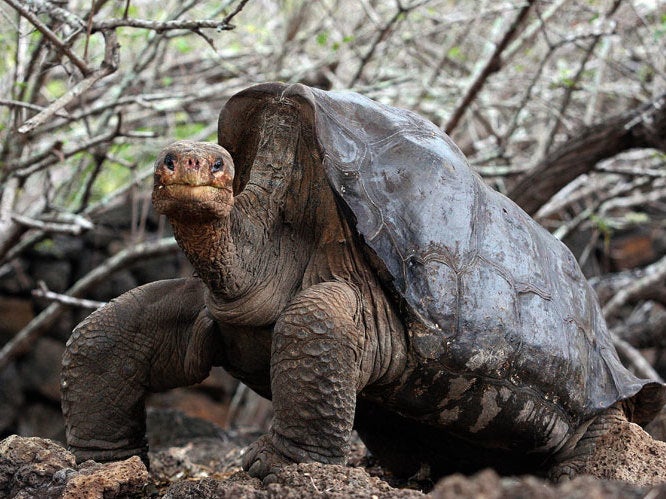Lonesome George: Scientists are using DNA from last member of now-extinct giant tortoise species to crack secrets of long life
Centenarian symbol of conservation fight benefited from genetic duplications which helped to repair damaging DNA mutations and keep cancer at bay

Your support helps us to tell the story
From reproductive rights to climate change to Big Tech, The Independent is on the ground when the story is developing. Whether it's investigating the financials of Elon Musk's pro-Trump PAC or producing our latest documentary, 'The A Word', which shines a light on the American women fighting for reproductive rights, we know how important it is to parse out the facts from the messaging.
At such a critical moment in US history, we need reporters on the ground. Your donation allows us to keep sending journalists to speak to both sides of the story.
The Independent is trusted by Americans across the entire political spectrum. And unlike many other quality news outlets, we choose not to lock Americans out of our reporting and analysis with paywalls. We believe quality journalism should be available to everyone, paid for by those who can afford it.
Your support makes all the difference.Lonesome George, the giant Galapagos tortoise who became a symbol for the conservation movement as the last member of his species is, in death, helping scientists crack the secrets of long life.
DNA from the last of the now extinct Pinta Island tortoises and the related Aldabra giant tortoise which is native to the Indian Ocean has been studied by researchers from Yale University.
Giant tortoises can live well beyond a century and the team identified a host of genetic attributes which help them prevent cancerous mutations.
It is thought they could give new insights for healthy ageing in humans.
The findings also provide insights on the evolution and future conservation of these endangered tortoises, which developed to great size on isolated islands free from predators but are now threatened by habitat loss, climate change, poaching and invasive species.
“Lonesome George is still teaching us lessons,” said Dr Adalgisa Caccone, one of the authors of the study published in Nature Ecology and Evolution from Yale’s Department of Ecology and Evolutionary Biology.
While the repeated failures of efforts to help George reproduce made him symbolic of conservation battles, his DNA lives on in samples taken by Dr Caccone in 2010 – two years before he died.
Now Dr Caccone and colleagues are using the information from his genome to conduct comparison studies with other tortoise and animal species to isolate the differences that could underpin healthy ageing.
One key area of research focused on why cancer is so rare in these creatures, even though larger animals are theoretically at greater risk – a phenomenon that is also seen in taller humans.
The researchers found that the giant tortoise genome has duplicated many of the genes found in other animal species which are dedicated to suppressing tumours.
These genetic instructions are key regulators of cellular processes and division, and can play a variety of roles from triggering the self-destruction of defective cells to preventing rampant duplication.
As animals age, mutations arise throughout the genetic code from exposure to carcinogens, like UV rays, and from simple errors as DNA is copied.
Mutations in a tumour suppressor gene can prevent it fulfilling its function and allow a tumour to begin growing beyond the control of the immune system, but having multiple copies of these genes reduces the risk if any one copy is mutated.
The authors also found similar expansion of the genomic regions linked to DNA repair, metabolism and the immune system, which are not seen in shorter-lived animals. These could allow the giant tortoises to weather infections and survive food shortages, which could also explain their large size and longevity.
Carlos Lopez-Otin, form the University of Oveido, Spain, was another of the study’s authors and he said that these features could help improve our understanding of the key hallmarks of old age.
“We had previously described nine hallmarks of ageing, and after studying 500 genes on the basis of this classification, we found interesting variants potentially affecting six of those hallmarks in giant tortoises, opening new lines for ageing research,” he added.
Join our commenting forum
Join thought-provoking conversations, follow other Independent readers and see their replies
Comments